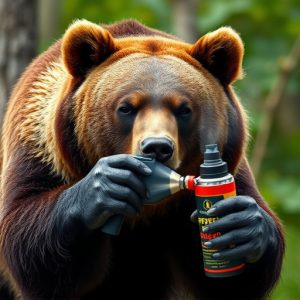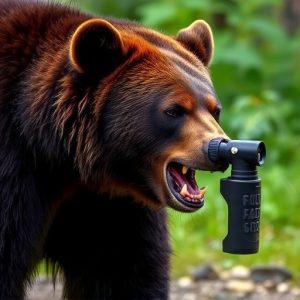Bear Attack Protection: Understanding Behavior & Choosing Bear Spray
Before venturing into bear country, understand bear behavior and choose between bear spray (for long…….
Before venturing into bear country, understand bear behavior and choose between bear spray (for long-range defensive against aggressive bears) and regular pepper spray (for close-quarters self-defense). A multi-layered safety approach, including gear, food storage, noise making, and local bear behavior knowledge, is vital for safe wilderness exploration.
“Exploring the wilderness should be an adventure, not a fear-inducing experience. With knowledge and preparation, understanding bear behavior can prevent potential attacks. This article equips readers with essential insights, starting from deciphering bear actions to demystifying the effectiveness of bear spray—a crucial tool for survival. We delve into ‘Bear Spray vs Regular Pepper Spray,’ offering a comprehensive comparison to ensure you’re protected. Learn how to choose the ideal bear spray and discover additional safety measures beyond sprays.”
- Understanding Bear Behavior: Key Factors to Consider Before a Encounter
- Demystifying Bear Spray: How Does It Work and What Are Its Limitations?
- Regular Pepper Spray vs Bear Spray: A Comprehensive Comparison
- Choosing the Right Bear Spray: Factors to Determine Your Protection Level
- Beyond Bear Spray: Additional Measures for Enhanced Wilderness Safety
Understanding Bear Behavior: Key Factors to Consider Before a Encounter
Understanding bear behavior is crucial before venturing into wilderness areas known for bear populations. Key factors to consider include understanding different bear species and their feeding habits, recognizing signs of bear presence, and learning how to minimize potential threats. Bears are typically wary of humans, preferring to avoid encounters rather than initiate aggression. However, certain behaviors from humans can trigger defensive reactions. For instance, making sudden movements, loud noises, or approaching a bear’s space can be misconstrued as a threat.
When preparing for potential bear encounters, the choice between bear spray and regular pepper spray is an important one. Bear spray, specifically designed for use against bears, is typically more effective at long ranges (up to 20 feet) and is formulated to reduce irritation over a larger area, minimizing the risk of inhalation that can occur with regular pepper spray. Regular pepper spray still offers protection in close-quarters situations, but its effectiveness against bears may be limited, especially if the bear is aggressive or charged directly at you.
Demystifying Bear Spray: How Does It Work and What Are Its Limitations?
Bear spray, a specialized defense mechanism against aggressive bears, has gained popularity as a wilderness survival tool. Unlike regular pepper spray, bear spray is designed to be effective at longer ranges and against larger, more powerful animals like grizzly bears. It works by delivering a high concentration of capsaicin, the active ingredient responsible for the burning sensation associated with chili peppers, directly into the bear’s eyes and respiratory system. This irritates and disorients the animal, providing the user with precious time to escape or defend themselves.
However, it’s crucial to understand the limitations of bear spray. While effective in many cases, its performance can vary based on factors like weather conditions (rain or high winds can reduce its range), the angle and proximity of the attack, and even the type of bear involved. Additionally, bear spray is not a guaranteed solution; some encounters may still result in injury or death despite its use. Thus, it’s essential to combine its use with proper bear awareness, avoidance techniques, and other safety measures for comprehensive protection while navigating bear country.
Regular Pepper Spray vs Bear Spray: A Comprehensive Comparison
When it comes to protecting yourself from bear attacks in the wilderness, the choice between regular pepper spray and specialized bear spray is crucial. While both are capsaicin-based irritants designed to disable attackers, they differ significantly in terms of effectiveness, range, and specific compounds.
Bear spray, as the name suggests, is formulated with a higher concentration of capsaicin and other chemicals targeted at bears’ sensitive eyes and respiratory systems. Its primary purpose is to deter aggressive bears, providing users with an escape route. In contrast, regular pepper spray, often used for self-defense against humans, has varying concentrations and may not always be effective against larger predators like bears. Bear spray typically offers a longer range, ensuring the user can defend themselves from a distance, while regular pepper spray is more suitable for close-quarters defense. The unique blend of chemicals in bear spray also helps reduce the risk of inhalation by potential victims, making it a safer option during encounters with these wild animals.
Choosing the Right Bear Spray: Factors to Determine Your Protection Level
Choosing the right bear spray is crucial for your wilderness survival. Unlike regular pepper spray, bear spray is specifically designed to deter aggressive bears by targeting their eyes and respiratory system. Key factors to consider include the concentration of capsaicin (the active ingredient), range and spray pattern. High-quality bear sprays typically contain 15% to 20% capsaicin, offering superior effectiveness compared to regular pepper spray. The spray pattern should cover a wide area, ensuring you can protect yourself at various distances.
Additionally, check the recommended range for each brand, as this varies from 20 to 30 feet (6 to 9 meters). Some advanced models even feature a dual-nozzle design for both close-range and long-range protection. Always test your bear spray in controlled settings before venturing into the wild, ensuring its functionality and your understanding of its range and effectiveness.
Beyond Bear Spray: Additional Measures for Enhanced Wilderness Safety
In addition to carrying bear spray—a potent deterrent specifically designed for wildlife encounters—wilderness enthusiasts should consider a multi-layered approach for enhanced safety. While bear spray is an effective tool, regular pepper spray may not offer the same level of protection against larger bears due to its less concentrated capsaicin levels and shorter range. For areas known for grizzly or black bear populations, investing in specialized survival gear, such as reinforced clothing and impact shields, can provide extra layers of defense.
Knowing local bear behavior, having a secure food storage system, and making noise while hiking are also crucial components. These additional measures, combined with proper training and awareness, significantly reduce the risk of bear attacks, ensuring a safer wilderness experience.
In the face of potential bear encounters, understanding both bear behavior and the unique capabilities of bear spray versus regular pepper spray is paramount. By equipping yourself with knowledge from “Understanding Bear Behavior” to “Choosing the Right Bear Spray,” you gain invaluable tools for wilderness safety. While no single method guarantees protection, a multi-layered approach including proper preparation, awareness, and the strategic use of bear spray enhances your chances in the event of an attack. Remember, staying informed and taking proactive measures can make all the difference when navigating wild landscapes.


